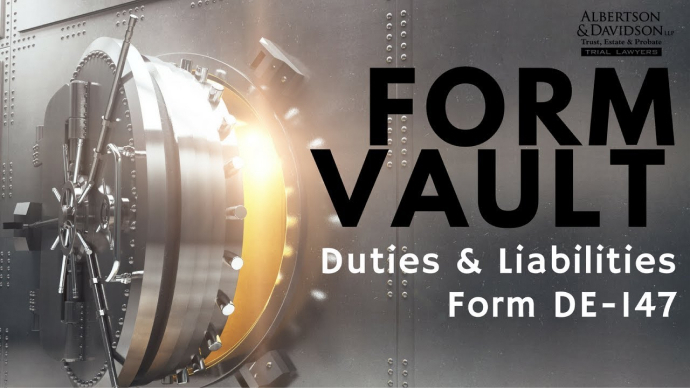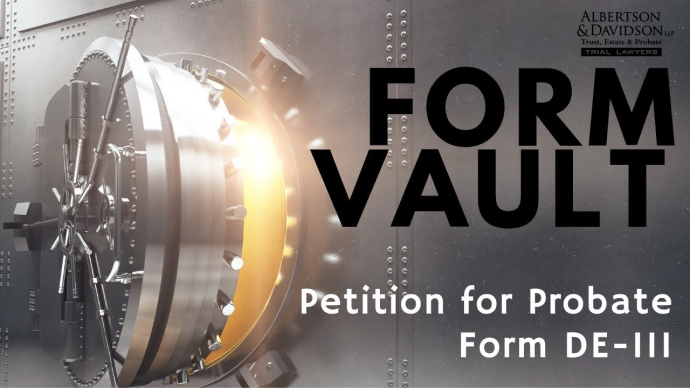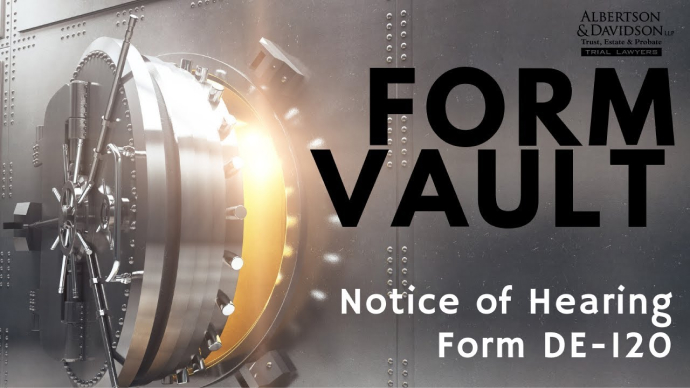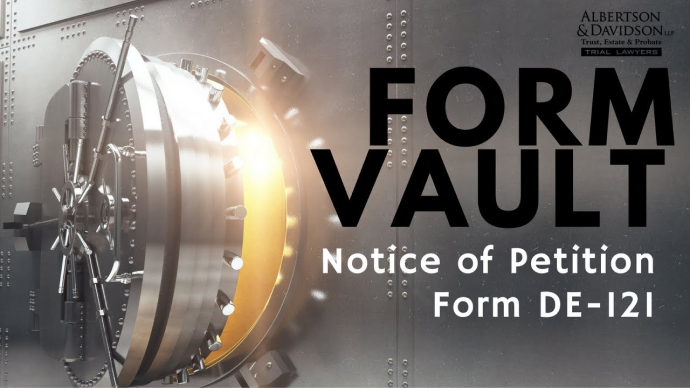Video Transcript
The following is an unedited, verbatim transcript of our video. It is not intended to be a stand-alone article.
Hi, this is Keith Davidson of Albertson & Davidson. In this video we are going over a form you’re going to need when you file your petition for probate and that’s form DE – 147 which is Duties and Responsibilities of a personal representative. So let’s take a look at that form and we’ll see what it does and how you need to fill out and file it. We start on Google and we just do a search for judicial council forms of California. All your forms are going to be here, very easy to find when you just come to the court website. And we are going to go down to probate and decedents estates and we’ll see those forms. Now, I already know the form number DE – 147, duties and responsibilities but if you didn’t know that you can do a search by name or by form number up here and you could locate it. So let me go over to the form and we’ll blow this up a little bit. So what we’re looking at here is that when you file a petition for probate the court wants to be sure that the personal representative, the person who’s going to manage that estate, understands or at least has a basic understanding of what their duties and obligations are and that’s what this form is for. So it’s going to go through, just kind of the highlights of the duties and responsibilities of an executor and then that named executor is going to have to sign this form and file it with the court so the court knows that they at least know a little something about what they have to do as an executor or administrator. And if you don’t have this form then the court is not going to accept your petition for probate filing.
So we start up the top and we are just going to fill it out and obviously if you’re representing yourself you just put your own name and address in here. Since I’m an attorney I’m going to put in my law firm information and my mailing address where I like all of my, oops, court mailings to go. And you’re going to want to fill out your telephone number, your email address, all of these stuff so that the court and the other parties can get a hold of you when they need to. If you’re representing yourself, you can just type in Pro Per here or you can put in your own name. So I would put in my own name like that if I’m representing myself. If I’m obviously an attorney I’m representing somebody else I’m going to put in their name. and we’re going to say this is in Los Angeles county, whatever county you’re in, just go ahead and fill that in and then you need to put in both the street address and the mailing address for the court where you’re going to be filing your petition for probate. If you don’t know the branch name, don’t worry about it, you can look it up on the website, the court’s website, of whatever county you’re in or you can just leave it blank if there’s none, not every court house has a branch name. And then the estate of, we’ve been using the example of Rachel Smith and they you’re going to need to put it your case number. Now you may not have your case number yet because you’re usually filling out this form and taking it with you to the court when you file your petition for probate, so you can leave that blank and the court will fill that in for you or you can fill it in after you file your petition for probate and the court assigns it a case number. You obviously need to be giving this to the personal representative and that personal representative needs to read this. This is really critical, important information and it’s not even all of the duties that a personal representative has but it’s some of the most important duties that they should at least know about. For example, they have to notify creditors, they must ensure a state property, they have to keep good records because they’re going to have to account at some point at the end of the case most likely. They have to inventory and appraise the estate assets, I mean managing the estate assets, these are critically important. The other thing that a lot of people don’t know in California is you cannot distribute assets out of the probate estate `to the beneficiaries without court approval. You have to have a court order for that. You can’t pay yourself or your attorney a probate fee without court approval yet. You have to a court order for that. So California’s probate process is very restrictive and there’s a lot of states out there that have kind of liberalized their probate process and made it easier to do outside of court. California hasn’t really done that, almost everything we do has to be done in court. You can be given some powers to do some things without court approval but all the important stuff especially opening the estate, approving the assets in the estate, closing the estate, paying everybody out, paying yourself, paying your attorneys, it all takes court oversight and a court order. So it’s a different process that a lot of states have nowadays. So you’re going to give this to the personal representative or you’re going to review it if you’re the personal representative. Read through it, make sure you understand it. And then down here you’re going to acknowledge that you received it. So I have petitioned the court to be appointed as a personal representative. My address and telephone number are, so you’re going to put in your address and telephone number whoever the personal representative is. And I acknowledge that I have received a copy of this statement of the duties and liabilities of the office of personal representative. And then you’re going to date it and you’re going to type in your name and you’re going to print it out and sign it. And so that’s really, it’s a simple form in the sense that you don’t have to fill out a whole lot. The form is just kind of a notice that the executor needs to sign or the personal representative needs to sign and acknowledging that notice but it’s a very crucially important form because if the personal representative doesn’t know this information they’re going to be in for a lot of trouble. So you’ll save this form, you’ll print it out, take it to the court with you, the court will stamp it up in this area here this blank area and then you’ll file it with the case number and you’ll be good to go.




